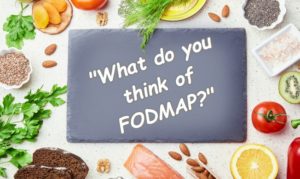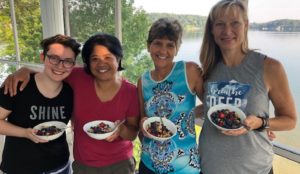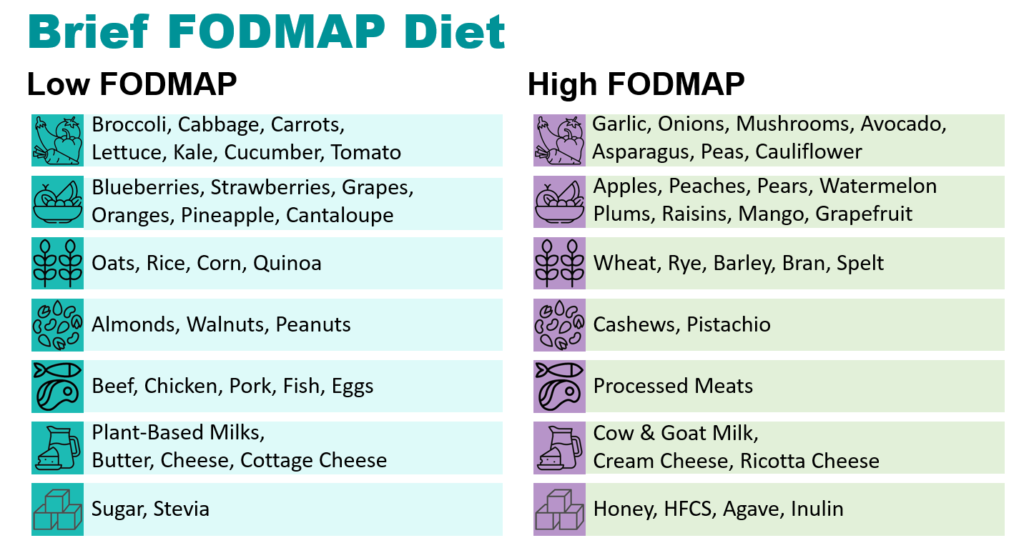 Have you heard of the FODMAP Diet (or the Low-FODMAP Diet)?
Have you heard of the FODMAP Diet (or the Low-FODMAP Diet)?
For some reason, we have gotten a lot of questions about this diet recently. So, we thought we should share some perspective…what it is, why people do it, and our take on it.
What is “FODMAP?”
FODMAP stands for Fermentable Oligosaccharides, Disaccharides, Monosaccharides, And Polyols. That completely clears it up, right?! Let’s go one level deeper:
Fermentable: this means your gut bacteria eats it up and produces gases.
Oligosaccharides: carbs made up of “a few” sugars. Examples of where you find them: wheat, rye, onions, garlic, watermelon, stone fruits, beans, pistachios, artichokes, others.
Disaccharides: carbs made up of two sugars. Examples of where you find them: dairy products like milk, yogurt, ice cream and some cheeses.
Monosaccharides: carbs made up of one sugar. Examples of where you find them: fructose found in honey, apples, pears, cherries, asparagus, high fructose corn syrup, others.
And
Polyols: sugar alcohols. Examples of where you find them: fruits and vegetables like prunes and cauliflower, as well as artificial sweeteners like sorbitol and xylitol.
If you are still confused, these are all sugars and sugar derivatives. Some are natural (like those found in garlic, milk, apples and cauliflower) while others are processed / formulated (like high fructose corn syrup and many sweeteners that end in “-ol”).
The following is a brief overview of the foods both HIGH (to choose less of) and LOW (to choose more of). And yes, these are RANDOM, and hard to memorize, so a chart on the fridge may help: FODMAP Foods Eat REAL America.
Why do some people try to avoid these “FODMAP” foods?
Most people can eat these foods just fine. However, people with Irritable Bowel Syndrome (IBS) or Small Intestinal Bacterial Overgrowth (SIBO) may benefit from changes in their dietary choices. These people may suffer from cramping, diarrhea, constipation, gas and/or bloating after eating some high FODMAP foods. They are often looking for an answer to why some foods send them running to the bathroom while others don’t.
Monash University, who has done a lot of work in this area, estimates as many as 15% of the world’s population is affected by IBS, and many of these people may experience relief if they make some shifts in what they eat.
How does it work?
 People typically do this as an elimination type of diet. Ideally, for anyone who does this, they should do it in conjunction with a dietitian or qualified medical professional.
People typically do this as an elimination type of diet. Ideally, for anyone who does this, they should do it in conjunction with a dietitian or qualified medical professional.
The first phase is abstaining from the long list of high FODMAP foods and ingredients (this typically lasts several weeks). If symptoms improve after several weeks, some of these foods are slowly reintroduced into the diet to try to determine which ones are triggering the symptoms.
Then, the person’s diet can be customized for each person to avoid or limit the foods that are creating the issues for THEM.
Zonya Says…
 Two summers ago, I invited a group of girls to my lake home. One said, “I try to follow the FODMAP diet. And if I don’t, I won’t be able to go out on the boat. I just can’t be away from a bathroom!”
Two summers ago, I invited a group of girls to my lake home. One said, “I try to follow the FODMAP diet. And if I don’t, I won’t be able to go out on the boat. I just can’t be away from a bathroom!”
She was in her 20’s, struggling with the restrictions, and mostly choosing convenience due to not wanting or having the time to cook. I whipped out the list, putting the foods WE COULD HAVE big and bold on the fridge. I planned all the meals for the weekend and told everyone what to bring.
When she arrived, she wasn’t feeling great. Diet adherence was a challenge for her, and she didn’t go out on the boat with us. But I had the meals planned perfectly, and we cooked together from there on out. I thought we would miss the garlic and onions, but we didn’t. We focused on all the fruit and veggies we could have and kept it gluten-free. We had the most delicious Neapolitan Overnight Oats, Grilled Trout, Summer Squash Quinoa, Summer Explosion Salad and Citrus Grilled Vegetables. By Saturday evening her tummy was feeling GREAT and out on the boat she went!
 She’s a singer and guitar player, so we sang to our heart’s content late into the night under a full moon. She left with an EAT REAL cookbook, knowing all she had to do is eliminate the garlic and onions and swap out a few fruits and veggies here and there. It was great learning something so simple (yet so RANDOM!) can be so life-changing for many.
She’s a singer and guitar player, so we sang to our heart’s content late into the night under a full moon. She left with an EAT REAL cookbook, knowing all she had to do is eliminate the garlic and onions and swap out a few fruits and veggies here and there. It was great learning something so simple (yet so RANDOM!) can be so life-changing for many.
So, the FODMAP diet is still REAL food, just more of some and less of others. And she really learned that cooking at home is KEY to control and it really can be simple and delicious!
So, now you know!
Please keep in mind, if you have a reason to try to eliminate foods that are causing IBS and related issues, that is one thing. But for everyone else, we do not recommend restricting all of these delicious and nutritious REAL foods!
Have you known someone who experimented with a Low-FODMAP diet?
We would love to hear your story!
 LEARN MORE ABOUT THE NAPKIN!
LEARN MORE ABOUT THE NAPKIN!

Good article! I have IBS and tried following the FODMAP plan but didnt stick with it diligently.
Thank you for your informative thoughts, Zonya. I suffer from IBS and I recently discovered the FODMAP diet and it truly does work as long as I stick to it. Many times it’s hard to follow the diet and can be depressing but it’s the horrible symptoms I experience if I don’t follow the diet that helps to keep me honest. Eating cashews (I love cashews) just isn’t worth the pain and awful feeling I experience. I’m very glad and thankful I found out about the FODMAP diet. Also, I am very thankful for Monash University as they make it easy for me to check if a particular food is low FODMAP or not with their resourceful app.